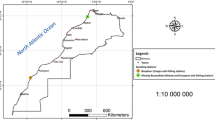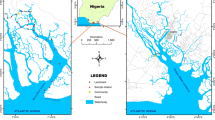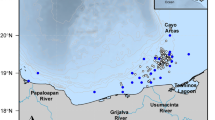Abstract
Concentrations of products of biotransformation of polycyclic aromatic hydrocarbons (PBPAH) were measured in bile of five fishes of nutritional, cultural and ecological relevance from the Athabasca/Slave river system. Samples were collected in Alberta and the Northwest Territories, Canada, during three seasons. As a measure of concentrations of PBPAHs to which fishes are exposed and to gain information on the nature and extent of potential exposures of people or piscivorous wildlife, concentrations of biotransformation products of two- and three-ringed, four-ringed and five-ringed PAHs were measured using synchronous fluorescence spectroscopy. Spatial and seasonal differences were observed with greater concentrations of PBPAHs in samples of bile of fish collected from Fort McKay as well as greater concentrations of PBPAHs in bile of fish collected during summer compared to those collected in other seasons. Overall, PBPAHs were greater in fishes of lower trophic levels and fishes more closely associated with sediments. In particular, goldeye (Hiodon alosoides), consistently contained greater concentrations of all the PBPAHs studied.


Similar content being viewed by others
References
Aas, E., & Klungsøyr, J. (1998). Biotransformation products of PAH in bile and EROD activity in North Sea fish. Marine Environmental Research, 46(1–5), 229–232.
Abrajano, T. A., Yan, B., & O’Malley, V. (2003). High molecular weight petrogenic and pyrogenic hydrocarbons in aquatic environments. In Sherwood B. Lollar (Ed.), Environmental geochemistry treatise on geochemistry (Vol. 9, pp. 475–509). Oxford: Elsevier Ltd.
Akre, C. J., Headley, J. A., Conly, M. F., Peru, M. K., & Dickson, L. C. (2004). Spatial patterns of natural polycyclic aromatic hydrocarbons in sediment in the Lower Athabasca river. Journal of Environmental Science and Health, Part A: Toxic/Hazardous Substances and Environmental Engineering, 39(5), 1163–1176.
Ariese, F., Kok, S. J., Verkaik, M., Gooijer, C., Velthorst, N. H., & Hofstraat, J. W. (1993). Synchronous fluorescence spectrometry of fish bile: A rapid screening method for the biomonitoring of PAH exposure. Aquatic Toxicology, 26(3–4), 273–286.
Beyer, J., Jonsson, G., Porte, C., Krhn, M. M., & Ariese, F. (2010). Analytical methods for determining metabolites of polycyclic aromatic hydrocarbon (PAH) pollutants in fish bile: A review. Environmental Toxicology and Pharmacology, 30(3), 224–244.
Borga, K., Aaron, T. F., Paul, H., & Derek, C. G. M. (2004). Biological and chemical factors of importance in the bioaccumulation and trophic transfer of persistent organochlorine contaminants in arctic marine food webs. Environmental Toxicology and Chemistry, 23(10), 2367–2385.
Braune, B., Muir, D., DeMarch, B., Gamberg, M., Poole, K., Currie, R., et al. (1999). Spatial and temporal trends of contaminants in Canadian Arctic freshwater and terrestrial ecosystems: A review. Science of the Total Environment, 230(1–3), 145–207.
Coat, S., Monti, D., Legendre, P., Bouchon, C., Massat, F., & Lepoint, G. (2011). Organochlorine pollution in tropical rivers (Guadeloupe): Role of ecological factors in food web bioaccumulation. Environmental Pollution, 159(6), 1692–1701.
Conly, M. F., Crosley, R. W., & Headley, J. V. (2002). Characterizing sediment sources and natural hydrocarbon inputs in the lower Athabasca river, Canada. Journal of Environmental Engineering and Science, 1(3), 187–199.
Deutsch-Wenzel, R. P., Brune, H., Grimmer, G., Dettbarn, G., & Misfeld, J. (1983). Experimental studies in rat lungs on the carcinogenicity and dose–response relationships of eight frequently occurring environmental polycyclic aromatic hydrocarbons. Journal of the National Cancer Institute, 71, 539–544.
Dillon, P., Dixon, G. D., Driscoll, C., Giesy, J. P., Hurlbert, S., & Nriagu, J. (2011). Evaluation of four reports on contamination of the athabasca river system by oil sands operations. Prepared by Water Monitoring Data Review Committee. Prepared for Government of Alberta.
EscartÍn, E., & Porte, C. (1999a). Assessment of PAH pollution in coastal areas from the NW Mediterranean through the analysis of fish bile. Marine Pollution Bulletin, 38(12), 1200–1206.
EscartÍn, E., & Porte, C. (1999b). Biomonitoring of PAH pollution in high-altitude mountain lakes through the analysis of fish bile. Environmental Science and Technology, 33(3), 406–409.
Evans, M. S., Muir, D., Lockhart, W. L., Stern, G., Ryan, M., & Roach, P. (2005). Persistent organic pollutants and metals in the freshwater biota of the Canadian Subarctic and Arctic: An overview. Science of the Total Environment, 351–352, 94–147.
Fuentes-Rios, D., Orrego, R., Rudolph, A., Mendoza, G., Gavilan, J. F., & Barra, R. (2005). EROD activity and biliary fluorescence in Schroederichthys chilensis (Guichenot 1848): Biomarkers of PAH exposure in coastal environments of the South Pacific Ocean. Chemosphere, 61(2), 192–199.
Gagné, F., Andre, C., Douville, M., Talbot, A., Parrott, J., McMaster, M., & Hewitt, M. (2011). An examination of the toxic properties of water extracts in the vicinity of an oil sand extraction site. Journal of Environmental Monitoring, 13, 3075–3086.
Gentes, M., Waldner, C., Papp, Z., & Smits, J. E. G. (2006). Effects of oil sands tailings compounds and harsh weather on mortality rates, growth and detoxification efforts in nestling tree swallows (Tachycineta bicolor). Environmental Pollution, 142(1), 24–33.
Guo, X., Yuan, D., Jiang, J., Zhang, H., & Deng, Y. (2013). Detection of dissolved organic matter in saline–alkali soils using synchronous fluorescence spectroscopy and principal component analysis. Spectrochimica Acta Part A: Molecular and Biomolecular Spectroscopy, 104, 280–286.
Han, S., Cheng, X., Ma, S., & Ren, T. (2006). Application of synchronous fluorescence spectrometry in separation of aromatics from hydrotreated naphthenic oil. Petroleum Science and Technology, 24(7), 851–858.
Headley, J. V., Marsh, P., Akre, C. J., Peru, K. M., & Lesack, L. (2002). Origin of polycyclic aromatic hydrocarbons in lake sediments of the Mackenzie Delta. Journal of Environmental Science and Health, Part A: Toxic/Hazardous Substances and Environmental Engineering, A37(7), 1159–1180.
Insausti, D., Carrasson, M., Maynou, F., Cartes, J. E., & Sole, M. (2009). Biliary fluorescent aromatic compounds (FACs) measured by fixed wavelength fluorescence (FF) in several marine fish species from the NW Mediterranean. Marine Pollution Bulletin, 58(11), 1635–1642.
Jimenez, B. D., Cirmo, C. P., & McCarthy, J. F. (1987). Effects of feeding and temperature on uptake, elimination and metabolism of benzo(a)pyrene in the bluegill sunfish (Lepomis macrochirus). Aquatic Toxicology, 10(1), 41–57.
Johnson, J. H., McKenna, J. E., Chalupnicki, M. A., Wallbridge, T., & Chiavelli, R. (2009). Feeding ecology of lake whitefish larvae in eastern Lake Ontario. Journal of Great Lakes Research, 35(4), 603–607.
Jung, J., Kim, M., Yim, U. H., Ha, S. Y., An, J. G., Won, J. H., et al. (2011). Biomarker responses in pelagic and benthic fish over 1 year following the Hebei Spirit oil spill (Taean, Korea). Marine Pollution Bulletin, 62(8), 1859–1866.
Kavanagh, R. J., Burnison, B. K., Frank, R. A., Solomon, K. R., & Van Der Kraak, G. (2009). Detecting oil sands process-affected waters in the Alberta oil sands region using synchronous fluorescence spectroscopy. Chemosphere, 76(1), 120–126.
Kean, Sam. (2009). Eco-Alchemy in Alberta: The oil of the future has serious reclamation challenges right now. Science, 326, 1052–1055.
Kelly, E. N., Schinder, W. D., Hodson, V. P., Short, W. J., Radmanovich, R., & Nielson, C. C. (2009). Oil sands development contributes polycyclic aromatic compounds to the Athabasca river and its tributaries. Proceedings of the National Academy of Sciences of the United States of America, 106(52), 22346–22351.
Kerr, S. J., Corbett, B. W., Hutchison, N. J., Kinsmen, D., Leach, J. H., Puddister, D., Stanfield, L., & Ward, N. (1997). Walleye habitat: A synthesis of current knowledge with guidelines for conservation (Percid Community Synthesis Walleye Habitat Working Group).
Kidd, K. A., Schindler, D. W., Hesslein, R., & Muir, D. C. G. (1998). Effects of trophic position and lipid on organochlorine concentrations in fishes from subarctic lakes in Yukon Territory. Canadian Journal of Fisheries and Aquatic Sciences, 55(4), 869–881.
Larsson, P., Collvin, L., Okla, L., & Meyer, G. (1992). Lake productivity and water chemistry as governors of the uptake of persistent pollutants in fish. Environmental Science and Technology, 26, 346–352.
Law, R. J., Dawes, V. J., Woodhead, R. J., & Matthiessen, P. (1997). Polycyclic aromatic hydrocarbons (PAH) in seawater around England and Wales. Marine Pollution Bulletin, 34(5), 306–322.
Leonard, J., & Hellou, J. (2001). Separation and characterization of gall bladder bile metabolites from speckled trout, Salvelinus fontinalis, exposed to individual polycyclic aromatic compounds. Environmental Toxicology and Chemistry, 20, 618–623.
Lin, E. L. C., Cormier, S. M., & Torsella, J. A. (1996). Fish biliary polycyclic aromatic hydrocarbon metabolites estimated by fixed-wavelength fluorescence: Comparison with HPLC-fluorescent detection. Ecotoxicology and Environmental Safety, 35(1), 16–23.
Margenau, T. L., Rasmussen, P. W., & Kampa, J. M. (1998). Factors affecting growth of northern pike in small northern Wisconsin lakes. North American Journal of Fisheries Management, 18, 625–639.
McCarthy, L. H., Williams, T. G., Stephens, G. R., Peddle, J., Robertson, K., & Gregor, D. J. (1997). Baseline studies in the Slave river, NWT, 1990–1994: Part I. Evaluation of the chemical quality of water and suspended sediment from the Slave river (NWT). Science of the Total Environment, 197(1–3), 21–53.
McDonald, S. J., Kennicutt, M. C., Liu, H., & Safe, S. H. (1995). Assessing aromatic hydrocarbon exposure in Antarctic fish captured near Palmer and McMurdo stations Antarctica. Archives of Environmental Contamination and Toxicology, 29, 232–240.
McGill, R., Tukey, J. W., & Larsen, W. A. (1978). Variation of box plots. American Statistician, 32, 12–16.
Nkpaa, K. W., Wegwu, M. O., & Essien, E. B. (2013). Assessment of polycyclic aromatic hydrocarbons (PAHs) levels in two commercially important fish species from crude oil polluted waters of Ogoniland and their carcinogenic health risks. Journal of Environment and Earth Science, 3(8), 128–137.
Parajulee, A., & Wania, F. (2014). Evaluating officially reported polycyclic aromatic hydrocarbon emissions in the Athabasca oilsands region with a multimedia fate model. Proceedings of the National Academy of Sciences of the United States of America (pp. 1–6).
Pharr, D. Y., McKenzie, K. J., & Hickman, A. B. (1992). Fingerprinting petroleum contamination using synchronous scanning fluorescence spectroscopy. Groundwater, 30(4), 484–489.
Polacek, M. C., Baldwin, C. M., & Knuttgen, K. (2006). Status, distribution, diet, and growth of burbot in Lake Roosevelt, Washington. Northwest Science, 80(3), 153–164.
Regional Aquatics Monitoring Program (RAMP). (2012). [cited January 24 2013]. http://www.ramp-alberta.org/ramp.aspx.
Rieger, P. W., & Summerfelt, R. C. (1997). The influence of turbidity on larval walleye, Stizostedion vitreum, behavior and development in tank culture. Aquaculture, 159(1–2), 19–32.
Ruddock, P. J., Bird, D. J., & McCalley, D. V. (2002). Bile metabolites of polycyclic aromatic hydrocarbons in three species of fish from the Severn Estuary. Ecotoxicology and Environmental Safety, 51(2), 97–105.
Scott, W. B., & Crossman, E. J. (1979). Freshwater fishes of Canada. Ottawa: The Bryant Press Limited.
Simonin, H. A., Loukmas, J. J., Skinner, L. C., & Roy, K. M. (2008). Lake variability: Key factors controlling mercury concentrations in New York State fish. Environmental Pollution, 154(1), 107–115.
Soclo, H. H., Garrigues, P., & Ewald, M. (2000). Origin of polycyclic aromatic hydrocarbons (PAHs) in coastal marine sediments: Case studies in Cotonou (Benin) and Aquitaine (France) areas. Marine Pollution Bulletin, 40(5), 387–396.
Tang, R. W. K., Johnston, T. A., Gunn, J. M., & Bhavsar, S. P. (2013). Temporal changes in mercury concentrations of large-bodied fishes in the boreal shield ecoregion of northern Ontario, Canada. Science of the Total Environment, 444, 409–416.
Timoney, K. P., & Lee, P. (2009). Does the Alberta tar sands industry pollute? The scientific evidence. The Open Conservation Biology Journal, 3, 65–81.
Timoney, K. P., & Lee, P. (2011). Polycyclic aromatic hydrocarbons increase in Athabasca River Delta sediment: temporal trends and environmental correlates. Environmental Science and Technology, 45, 4278–4284.
Vuorinen, P. J., Keinanen, M., Vuontisjarvi, H., Barsiene, J., Broeq, K., Forlin, L., et al. (2006). Use of biliary Biotransformation products of PAH as a biomarker of pollution in fish from the Baltic Sea. Marine Pollution Bulletin, 53(8–9), 479–487.
Walker, C. H., Sibly, R. M., Hopkin, S. P., & Peakall, D. B. (2012). Fates of organic pollutants in individuals and organisms. Principles of ecotoxicology (pp. 63–93). New York: CRC Press.
Wayland, M., Headley, J. V., Peru, K. M., Crosely, R. W., & Brian, B. G. (2008). Levels of polycyclic aromatic hydrocarbons and dibenzothiophenes in wetland sediments and aquatic insects in the oil sands area of Northeastern Alberta, Canada. Environmental Monitoring and Assessment, 136(1–3), 167–182.
Yang, X., & Baumann, P. C. (2006). Biliary Biotransformation products of PAH and the hepatosomatic index of brown bullheads from Lake Erie tributaries. Ecological Indicators, 6(3), 567–574.
Yunker, M. B., & Macdonald, R. W. (2002). PAHs in the Fraser River basin: A critical appraisal of PAH source and composition. Organic Geochemistry, 33, 489–515.
Acknowledgments
Portions of this study were funded by the Boreal Songbird Initiative (BSI); Aboriginal Affairs and Northern Development Canada (AANDC) and the Government of the Northwest Territories. PDJ is a Northern Environmental Toxicology Initiative Faculty member at the University of Saskatchewan. EO was supported by a New Faculty Scholarship to PDJ from the University of Saskatchewan. The research was supported, in part, by a Discovery Grant from the Natural Science and Engineering Research Council of Canada (Project # 326415-07) and a Grant from the Western Economic Diversification Canada (Project # 6578, 6807 and 000012711). The authors wish to acknowledge the support of an instrumentation grant from the Canada Foundation for Infrastructure. Prof. Giesy was supported by the Canada Research Chair program, a Visiting Distinguished Professorship in the Department of Biology and Chemistry and State Key Laboratory in Marine Pollution, City University of Hong Kong, the 2012 “High Level Foreign Experts” (#GDW20123200120) program, funded by the State Administration of Foreign Experts Affairs, the P. R. China, to Nanjing University and the Einstein Professor Program of the Chinese Academy of Sciences. We would like to thank the research team of Drs. Giesy and Jones, especially Tim Tse and Eric Higley for their assistance. First Nations and Métis communities of Fort Resolution, Fort Smith, Fort Chipewyan, Fort McKay and Fort McMurray and numerous Provincial and Federal agencies are acknowledged for their assistance during the sampling.
Author information
Authors and Affiliations
Corresponding author
Appendix
Appendix
See Table 5.
Rights and permissions
About this article
Cite this article
Ohiozebau, E., Tendler, B., Hill, A. et al. Products of biotransformation of polycyclic aromatic hydrocarbons in fishes of the Athabasca/Slave river system, Canada. Environ Geochem Health 38, 577–591 (2016). https://doi.org/10.1007/s10653-015-9744-6
Received:
Accepted:
Published:
Issue Date:
DOI: https://doi.org/10.1007/s10653-015-9744-6




